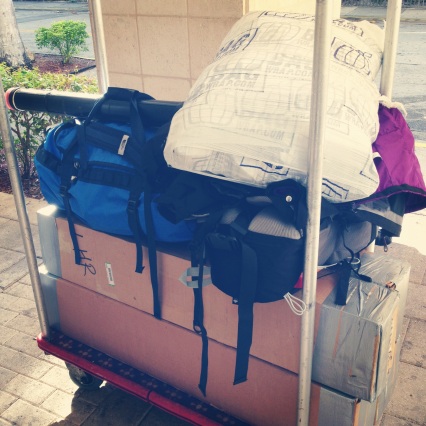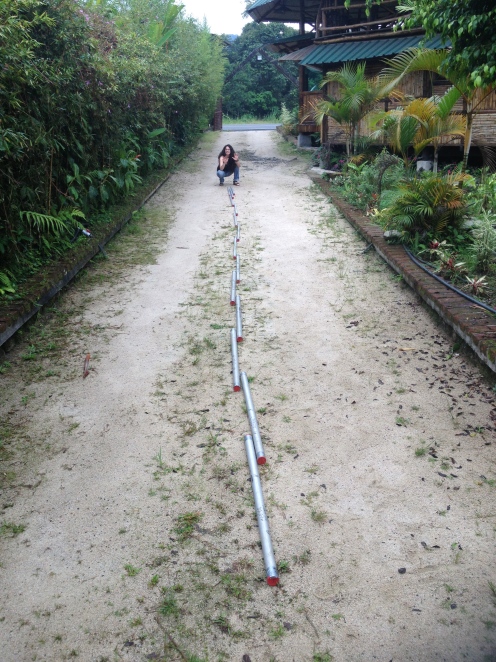PCRG COMPLETE AGAIN
I am glad to say that after almost two months out of the office running around with 8 bags of equipment, Frazer and I have finished our tour of the Americas. As the work has been so diverse, we would like to split our comments and impressions into two different posts, we hope you enjoy them!
PART I: THANKS FLORIDA
Our first two weeks were spent in Florida, attending the International Biogeography Society Meeting 2013, and sampling some exciting South American records in the Paleo Ecology Lab, headed by Prof. Mark Bush at the Florida Institute of Technology (FIT).
This was our first time at this conference and we would like to encourage the attendance of more palaeo-researchers in further meetings of this society. The talks highlighted the important role of multidisciplinary work for the understanding of species biogeography and just how valuable a paleo perspective of these issues is.
After the meeting, we drove to FIT in Melbourne to take samples for Chironomidae analysis from long records of Lakes Consuelo and Chalalan, and surface samples from another 10 South American lakes. During the stay, we also had the opportunity of developing a workshop between PhD students and postdocs from both research groups, sharing our fields of expertise so far. There were some great talks about R, GIS, Chironomidade and non-pollen palynomorphs analyses, etc.
We would like to thank Prof. Mark Bush for his good willingness and support during our stay. A huge special acknowledgement has to be made for all the people who made our stay so pleasant, thank you so much to Bryan, Angie and Pablo, hope to see you soon anywhere!
PART II: THANKS ECUADOR
To perform a palaeoecological field work during one month is hard.
To sample with a Livingstone corer for the first time without any already skilled person is hard.
To work in South America is hard.
To develop this work with just two people, none of them being from South America could be sometimes just a nightmare.
This could be the summary of our experience during the Ecuador field work if it wasn’t for the great people we have found during our trip. Besides our always cooperative institutional partners, Dr Patricia Mothes (Instituto Geofísico de Quito) and Dr Susana León Yánez (Pontificia Universidad Católica de Ecuador), we have shared wonderful moments with many different people; Anita Steinitz (Casa Cultural Trude-Sojka, Quito), or Dr Carlos Duche (Dirección de Educación Hispana, Puyo). In the field, we have lived some great experiences in several lovely locations, mainly Amazonian midlands (c. 1200 m elevation) and Andes (c. 4000 m elevation).
Our first stop was done in Mera, where we cored Laguna Pindo, located at the Estación Biológica Pindo Mirador. We have obtained a long record of c.11 m, yeah! We have no idea about the age of the sediment collected yet, as the samples are still travelling, but we hope that it will be a very interesting sequence for Ecuador. Moreover, we re-visited the Mera section, sampled on our last field work and took some additional samples for Hayley’s PhD project. For this work, the Biological Station staff have been invaluable, mainly the director Carmen Luzuriaga, Alcides García and Gloria Quichimbo (and her fabulous food!), thank you so much.
The Andean highlands are a very different landscape. Our sampling in the National Park of Cayambe Coca consisted in the collection of a peat bog sequence of c.5-6 m long, and surface samples for Chironomidae, pollen and non-pollen palynomorphs analyses of 4 different lakes. Cayambe Coca contains more than 70 lakes in an area c. 70000 ha, and is among the less disturbed Andean landscapes in northern Ecuador, where Polylepis sp. woodlands can be easily explored. It has been a real shame that we have used all the aluminium tubes we took with us and that we were just two people, because we are sure that the organic material in the peat bog was a lot deeper, and the lakes would be very nice archives to study recent regional trends in the Cayambe landscape.
On the bright side, we hope to come back soon and finish our work there. During our time up there, the rangers of the park joined us mostly all the time. They have been supporting us (no matter the hail or snow), and very interested in our work. Special thanks to Cesar Salazar and Wilson, hasta pronto muchachos!
There are so many other people who helped, supported, listened and shared their knowledge with us during this adventure. We hope they have enjoyed this time as much as we have done. Again, THANK YOU.
Encarni







Pingback: PCRG February | Palaeolimnology et al.